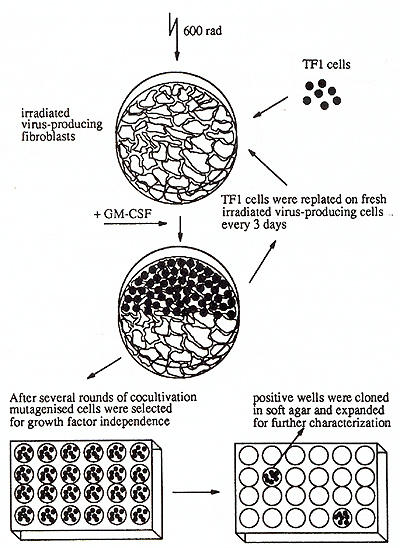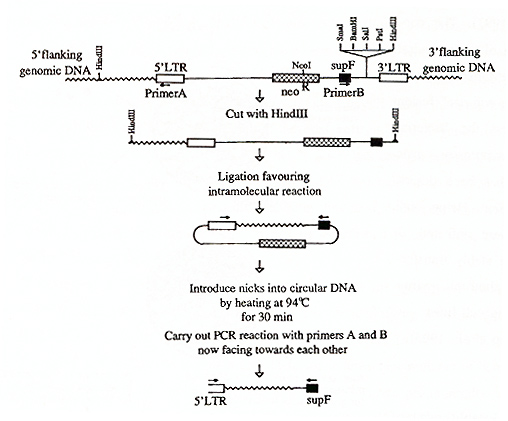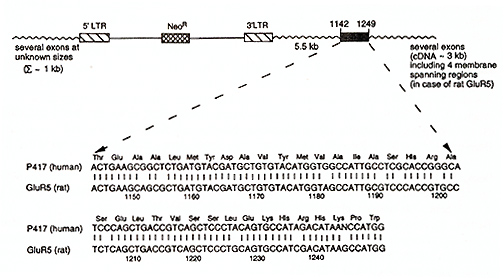Wolfram Ostertag, and Heinz Lother1. In: Zander AR et al. (eds) Gene Technolgy, Stem Cell and Leukemia Research, Nato ASI Series H: Cell Biology, Vol 94, Springer-Verlag, Berlin Heidelberg New York London |
|
Heinrich-Pette-Institut für Experimentelle Virologie
und Immunologie an der Universität Hamburg,
A protocol has been established which allows obtaining growth-factor-independent cell mutants by retroviral insertion mutagenesis in vitro. In order to identify gene alterations possibly leading to growth-factor independency, two techniques were established for the cloning of retroviral insertion sites. One technique makes use of the amplification of retroviral flanking fragments by inverse polymerase chain reaction (IPCR). The other strategy involves complementation of a truncated kanamycin gene present in abacterial plasmid vector by a neomycin gene fragment originating from the retroviral vector, which allows direct selection for kanamycin resistant bacterial cell clones. Using these techniques flanking fragments with several putative genes have been obtained. One flanking fragment shows high homology to the rat ionotrophic glutamate receptor, i.e. GluR5.
Omission of growth factor from proliferating cells leads to cell death unless oncogenes such as those encoding tyrosine kinase activity abrogate the factor requirement of factor-dependent cells (Pierce et al., 1985; Mathey et al., 1986; Wheeler et al., 1987; Cleveland et al., 1989; Katzav et al., 1989; Mecckling et al., 1992). In fact, in hematopoietic stem cells, the primary function of colony-stimulating factors appears to be suppression of programmed cell death (apoptosis, Williams et al., 1993), and this effect allows an intrinsically determined pathway of differentiation to be followed (Fairbairn et al., 1993). Several different messenger systems have been associated with induction of apoptosis, and the final response varies with the cell type and the other signals being received. Consequently, in addition to genes exclusively involved in cell death, there are likely to be some that can influence other aspects of cell behavior as well. In fact, genes mediating or modulating apoptosis such as myc, ras, p53, bcl-2, bcl-x, bax etc. are critically involved in control of proliferation and differentiation (reviewed by Freeman et. al., 1993). Since the molecular control of proliferation and differentiation has been studied far more extensively than control of apoptosis, some proteins with long established roles in these areas could also be important in apoptosis. Retroviral insertion mutagenesis has proved useful for identifying oncogenes in provirally induced tumors (Habets et al., 1994), and for identifying genes or genetic loci involved in growth factor independence (Stocking et al., 1988, Dorsers et al., 1993). We asked whether it is applicable to obtain growth-factor independent mutants of hematopoietic stem cells in vitro. We anticipated that retroviruses integrate preferentially into open chromosomal domains (reviewed by Breindl et. al. 1989), which may lead to: a) gene inactivation, b) gene truncation yielding an altered phenotype or c) constitutive gene expression due to an exchange of transcription control regions.
Establishment of growth-factor independent mutants The human, growth factor-dependent, hematopoietic precursor TF
-1 cell line derived from a patient with erythroleukemia (Kitamura
et al., 1989) was used for the retroviral insertion mutagenesis.
TF-l cells require IL-3 or GM-CSF for long term growth. Other factors
such as stem cell factor (SCF) and erythropoietin (Epo) induce short
term proliferative signals. TP A induces differentiation into macrophage
like cells. Hemin and Epo induce hemoglobin synthesis. TF-I mutants
grow stroma cell dependent (Itoh, et al., 1994). For infection with
the retroviral vector TF-l cells were cocultivated with irradiated
pM3neo-supF producing fibroblasts for 8 or 16 rounds of cocultivation.
Subsequent growth factor removal allowed the detection of growth-factor
independent cell mutants. This regime (Fig. 1) led to the generation
of 241 growth- factor independent cell lines (Stocking et at., 1993).
The construction of the retroviral vector pM3neo-sup containing
a gag-neoR fusion gene and the bacterial tRNA suppressor gene (sUpF)
has been described earlier. Helper cell lines were infected to establish
stably transfected amphotropic virusproducing cell lines (Stocking
et al., 1993). 
Since all our mutants contain more than one retroviral integration
we intended to clone large numbers of integration sites in order
to eliminate integration events not affecting genes involved in
factor independency. To achieve this, we initially attempted to
select for supF containing A phages of genomic phage libraries.
Due to the finding that the supF gene had suffered mutations ( data
not shown) probably during establishement of the packaging cell
line, this technique could not be used. The first technique applied
was therefore cloning by inverse PCR as is depicted in Figure 2.
It involves cutting of genomic DNA by a restriction enzyme, ligation
favouring intramolecular reaction (dilute solution), heating to
94°C for 30 min (nicking), and amplification of the circular genomic
DNA using two primers which recognise retroviral sequences. 
Genomic fragments in the range of 0.15 kb to 1.4 kb were obtained. Southern-blot and sequence analysis confirmed that these fragments respresent retroviral flanking sequences (data not shown). However, Southern-blot analysis revealed as well, that several of the cloned fragments contained repeat elements. Most of these repeat elements were identified by sequence analysis as to be Alu elements. The estimated copy number of 700 000 Alu elements per haploid genome predicts a density of one Alu repeat every 4 kb of genomic DNA (reviewed by Makalowski et al., 1994). At the cytogenetic level, Alu repeats are concentrated in R bands, the most transcriptionally active areas of the genome. Alu elements are found in introns of most of known actively transcribed genes. It appears that integration of the retroviral vectors occurred with some preference close to repeat sequences, mainly Alu elements.
Mainly due to inheritent problems encountered by the IPCR cloning
technique such as the presence of repeat elements within short fragments,
which in part did not allow any further analysis, we established
a second cloning protocol. We made use of the neomycin resistance
gene, which collfers kanamycill resistallce to bacteria. Since no
bacterial ribosomal bindillg site preceeded the neomycin gene, selecting
for the complete proviral sequence including 3'- and 5'- flanking
sequences could not be achieved. However, a cloning strategy for
3' flanking which involves cutting the genomic DNA by Nco I, ligation
into a plasmid vector containing the 5' end of the kanamycin gene
and a bacterial promoter depicted in Fig. 2 could be established.
To obtain the highest possible transformation efficiency, the following
parameters were optimized: bacterial strain, ligation conditions,
transformation conditions, DNA concentration, and field strength
(data to be shown elsewhere).  Fig. 3. Construction of the vector used for the cloning of 3' -flanking DN As by kanamycin gene complementation. Restriction of genomic DNA from TF-I mutants by Nco I and subsequent
Southemblot analysis using the Ncol/BamHI 3' fragment of the retroviral
vector (see fig. 2) revealed that all identified fragments were
larger than 2.5 kb, the size predicted by the vector part of the
cloned fragment ( data IlOt show-n). It is therefore suggested,
that deletions or recombinations of the 3' part of the retroviral
vector did occur with a rather low frequency if at all. Moreover,
all fragments cloned by the kanamycin gene complementation approach
did match in size with the corresponding genomic fragment seen by
Southern-blot analyis (data not shown). Southern-blot analysis revealed
as well, that approximately 50% of the cloned fragments do contain
Alu repeats. been published to date. Its chromosomal localisation,
however, has been assigned to 21q22 (Potier et a]., 1993) in the
vincinity of the gene for familial amyotrophic lateral sclerosis
(Eubanks et a]., 1993; Gregor et a]., 1993). 
This work was supported by a grant of the Deutsche Krebshilfe and AMGEN. The Heinrich-Pette-Institut is financially supported by Freie und Hansestadt Hamburg and Bundes ministerium für Gesundheit.
Auch, D., and Reth, M. (1990) Exon trap cloning: using PCR torapidly detect and clone exons from genomic DNA fragments. Nucl. Acid. Res. 18: 6743-6744. Barnard, E.C. (1992) Receptor classes and the transmitter-gated ion channels. Tibs. 17: 368-374. Beck, S., Kelly, A., Radley, E., Kurshid, F., Alderton, R.P., and Trowsdale J. (1992) DNA sequence analysis of 66 kb of the human MHC class II region encoding a cluster of genes for antigen processing. Mol. BioI. 228: 433-441. BettIer, B., Boulter, J., Hermans-Borgmeyer, I., O'Shea-greenfiel, A., Deneris, E. S., Moll, C., Borgmeyer, U., Hollmann, M., and Heinemann S. (1990) Cloning of a novel glutamate receptor subunit, GLUR5: expression in the nervous system during development. Neuron. 5: 583-595. Breindl, M., Scherdin, U., and Rhodes, K. (1989) Cellular target sequences for retroviral integration. In: Nato Asi Series, Vol H34. Vectors as tools for the study of normal and abnormal growth and differentiation. Lother, H., Demick, R., and Ostertag, W. eds Springer-Verlag Berlin Heidelberg. pp. 77-88. Cleveland, J.L., Dean, M., Rosenberg, N., Wang, J. Y.J. Rapp, U.R. (1989) Tyrosine kina se oncogenes abrogate intereleukin-3 dependence of murine myeloid cells through signaling pathways involving c-myc: Conditional regulation of c.myc transcription by temperture-sensitive v-abl. Mol. Cell. BioI. 9: 5685. Dorsers, L.C.J., Vanagthoven, T., Dekker, A., and Vanagthoven, T.L.A. (1993). Induction of anti-estrogen resistance in human breast cancer cells by random insertional mutagenesis using defective retroviruses: identification of bcar- I, a common integration site. Mol. Endocrinol. 7: 870-878. Eubanks, J.H., Puranam, R.S., Kleckner, N.W., Bet tIer, B., Heinemann, S.F., McNamara, J.O. (1993) The gene encoding the glutamate receptor subunit GluR5 is located on human chromosome 21 q21.1-22.1 in the vicinity of the gene for familial amyotrophic lateral sclerosis. Proc.Natl.Acad.Sci.USA. 90: 178-82 Fairbaim, L.J., Cowling, G.J., Reipert, B.M., and Dexter, T.M. (1993). Suppression of apoptosis allows differentiation and development of a multipotent hemopoietic cell line in the absence of added growth factors. Cell. 74: 823-832. Freeman, R.S., Estus; S., Horigome, K., and Johnson Jr., E.M. (1993) Cell death genes in invertebrates and (maybe) vertebrates. Current opinion in neurobiology. 3: 25-31. Gasic, G .P .and Heinemann, S. ( 1991) Recptors coupled to ionic channels: the glutamate receptor family. Current Opinion in Neurobiology. 1: 20-26. Gregor, P., Reeves, R.H., Jabs, E.W., Yang, X., Dackowski, W., Rochelle, J.M., Brown, R.H. Jr., Haines, J.L., O'Hara, B.F., Uhl, G.R., (1993) Chromosomal localizationof glutamate receptor genes: relationship to familial amyotrophic lateral sclerosis and other neurological disorders of mice and humans. Proc. Natl. Acad. Sci. USA. 90: 3053-7. Gregor, P., O'Hara' B.F., Yang, X., Uhl, G.R. (1993) Expression and novel isoforms of glutamate receptor genes GluR5 and GluR6. Neuroreport. 4: 1343-1346. Habets G. G. M., Scholtes E.H.M. Zuydgeests, D., van der Kammen, E.H.M., Stam, J.C., Berns, A., and Collard, J.G. (1994) Identification of an invasion-inducing gene, Tiam-1, that encodes a protein with homology to GDP-GTP exchangers for Rholike proteins. Cell 77: 537-549. Itoh, K., Klingler, K., 1aker, C., Just, U., Mannweiler, K., Mori, K.J., Nishikawa, S.-l., Bittner, S., Nibbs, R., Harrison, P.R., and Ostertag, W., (1994) Soluble growth factors induce transient growth and clonal extinction of stroma cell dependent erythroleukemia cells. submitted for publication. Katzav, S., Martin, Z.D., Barbacid, M., Hedge, A.M., Isfort, R., I hIe, J.N. (1989) The trk oncogene abrogates growth factor requirements and transforms hematopoietic cells. Oncogene. 4: 1129. Kitamura, T., Tange, T., Terasawa, T., Chiba, S., Kuwaki, T., Miyagawa, K., Piao, Y.F ., Miyazono, K., Urabe, A., and Takaku, F. (1989) Establishment and characterization of a unique human cell line that proliferates dependently on GM-CSF, 11-3, or erythropoietin. J. Cell. Physiol. 140: 323-334. Mathey, P.B., Nabel, G., Palacios, R., Baltimore, D. (1986). Abelson virus abrogation of interleukin-3 dependence in a lymphoid cell line. Mol. Cell BioI. 6: 4133. Makalowski, W., Mitchell, G. A., and 1abuda, D. (1994) Alu sequences in the coding region of mRNA: a source of protein variability. TIG. 10, 188-193. Mecckling, G.K., Yee, S.P., Schrader, J.W., Pawson, T. (1992) A retrovirus encoding the v-fps protein-tyrosine kinase induces factor-independent growth and tumorigenicity in FDC-P1 cells. Biochim. Biophys. acta. 1137: 65. Pierce, J.H., Di Fiori, PP., Aaronson, S.A., Potter, M., Pumphrey, J., Scott, A., I hIe, J.N. ( 1985). Neoplastic transformation of mast cells by Abelson-Mu1 V: Abrogation of 11-3 dependence by a nonautocrine mechanism. Cell. 41: 685. Potier, M.C., Dutriaux, A., 1ambolez, B., Bochet, P., Rossier, J. (1993) Assignment of the human glutamate receptor gene G1UR5 to 21q22 by screening a chromosome 21 Y AC library. Genomics. 15: 696- 7 Sommer, B., Seeburg, P.H. (1992) Glutamate receptor channels: Novel properties and new clones. Trends Pharmacol. Sci. 13: 291-296. Stocking, C., Bergholz, U., Friel, J., Klingler, K., Wagner, T., Starke, C., Kitamura, T., Miyajima, A., and Ostertag, W., (1993) Distinct classes of factor-independent mutants can be isolated after retroviral mutagenisis of a human myeloid stem cell line. Growth factors, 8: 197-209. Stocking, C., 1ö1iger, C., Kawai, M., Suciu, S., Gough, N., and Ostertag, W. (1988). Identification of genes involved in growth autonomy of hematopoietic cells by analysis of factor-independent mutants. Cell 53, 869-879. Wheeler, E.F., Askew, D., May, S., I hIe, J.N., Sherr, C.J. (1987). The v-fms oncogene induces factor-independent growth and transformation of the interleukin-3-dependent myeloid cell line FDC-P1. Mol. Cell BioI. 7: 1673. Wisden, W., and Seeburg, P.H. (1993) Mammalian ionotropic glutamate receptors. Current Opinion in Neurobiology. 3: 291-298. Williams, G. T ., and Smith, C.A. (1993) Molecular regulation of apoptosis: Genetic controls of cell death. Cell. 74: 777-779. |